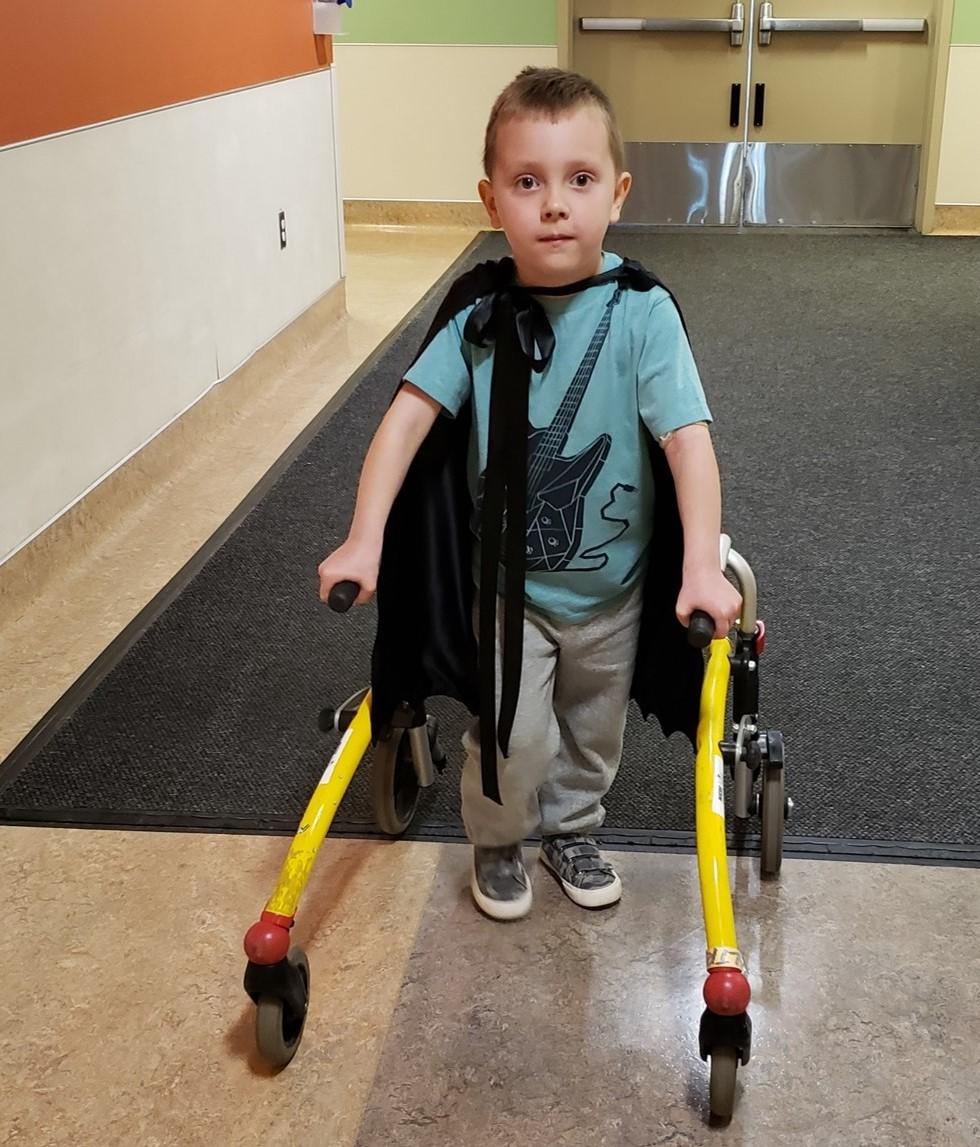Nov. 18, 2020
Research-intensive care saved Daniel’s life

Stacey Audley knows first-hand the life-saving difference research makes. Last year, her six-year-old son Daniel caught the flu — just like the rest of his family. Although everyone else was feeling better within a couple of days, Daniel wasn’t. Stacey picked him up to carry him downstairs to watch TV and he went limp in her arms. She and her husband, Keith, rushed him to the Alberta Children’s Hospital where he became completely unresponsive.
After suspicious findings on a CT (computerized tomography) scan, an MRI (magnetic resonance imaging) confirmed their worst fear — swelling of the brain stem. Daniel’s parents understood that if the swelling cut off the blood supply to his brain, it would be catastrophic. They knew this because exactly the same thing — rogue flu, swelling brain, and unresponsiveness — claimed the life of their daughter, Rebecca, 17 years earlier.
- Pictured above: Daniel Audley at Alberta Children's Hospital. Photo courtesy Audley family
“This can’t happen to our family again,” was all Audley could say to their son’s doctors. A team of experts specializing in paediatric intensive care, neuro-critical care (NCC), neurology, rheumatology, radiology and genetics — some of whom had been part of Rebecca’s care team years ago — all moved quickly and in concert with one another. Given the extent of the swelling and resulting injury to his brain, the risk of losing Daniel was high.
DNA sequencing leads to new research
New knowledge and treatments not previously available to Rebecca were now part of the arsenal in fighting Daniel's life-threatening condition. With the clinical and research teams working tirelessly to save him, Daniel benefited from a very aggressive treatment strategy — high dose steroids, apheresis, 24/7 monitoring of every vital sign and a cooling blanket to help slow his brain down to prevent further damage. The team used leading-edge brain-computer interface technologies to determine if Daniel was aware of his surroundings even though he couldn’t speak or move. To everyone’s relief, he was.
As he began to recover, Daniel’s team made a huge breakthrough. By sequencing his DNA, they were able to identify the gene responsible for the condition he shared with his sister. In a collaborative effort with scientists in Pennsylvania and North Carolina, that discovery has now kickstarted new research that will benefit families like the Audleys around the world.
“It brings me to tears knowing that kids will be the focus of even more research at the Alberta Children’s Hospital and the University of Calgary,” says Audley. “Without research to improve treatments, we know how Daniel’s story could have ended.”
“When children suffer from conditions as serious and as complex as Daniel’s, decisions need to be made quickly and continuously,” says Dr. Michael Esser, MD, PhD, a member of Daniel’s care team and director of the Paediatric NeuroCritical Care and Translational Research Program in the Alberta Children’s Hospital Research Institute at the Cumming School of Medicine.
“Test results that used to take months or years to turn around can now be obtained in days, sometimes hours," says Esser. "As we advance NCC and genomics, we believe we will be able to use our research to inform clinical decision-making at the bedside in real time.”

Daniel Audley leaves hospital wearing his superhero cape.
Courtesy Audley family
It was a long road to recovery once Daniel began breathing on his own. He worked hard with his rehabilitation, speech, occupational and physiotherapy teams. Within a few weeks, he was able to replace his wheelchair with a walker. Today, Daniel is fully recovered.
“We are forever grateful to everyone at the hospital — all the doctors, nurses, therapists and researchers who fought to save our son. Honestly, we really didn’t know if he would make it,” says Audley. “Now, because they worked so hard to protect his brain, we have our same happy boy back. When he put his skates on for the first time, Daniel asked us to take a picture and send it to his doctors saying, ‘Betcha they never thought I could do this!’”
Child Health and Wellness research strategy
The University of Calgary just announced Child Health and Wellness as a research priority, becoming a national leader in this critical area. Learn more
Michael Esser is a clinical associate professor in the Department of Paediatrics and a member of the Alberta Children’s Hospital Research Institute and the Hotchkiss Brain Institute at the Cumming School of Medicine.
Child Health and Wellness
The University of Calgary is driving science and innovation to transform the health and well-being of children and families. Led by the Alberta Children’s Hospital Research Institute, top scientists across the campus are partnering with Alberta Health Services, the Alberta Children’s Hospital Foundation, and our community to create a better future for children through research.





